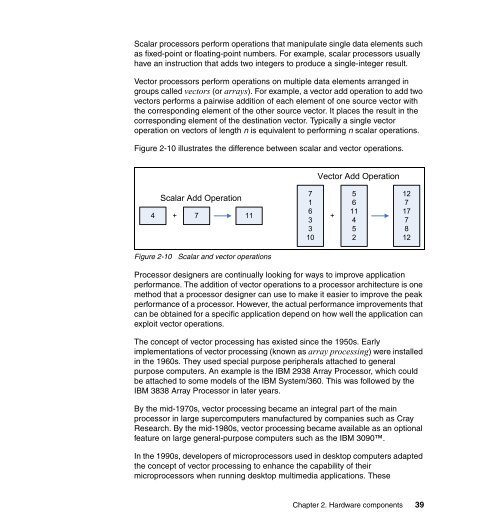The IBM eServer BladeCenter JS20 - IBM Redbooks
The IBM eServer BladeCenter JS20 - IBM Redbooks
The IBM eServer BladeCenter JS20 - IBM Redbooks
You also want an ePaper? Increase the reach of your titles
YUMPU automatically turns print PDFs into web optimized ePapers that Google loves.
Scalar processors perform operations that manipulate single data elements such<br />
as fixed-point or floating-point numbers. For example, scalar processors usually<br />
have an instruction that adds two integers to produce a single-integer result.<br />
Vector processors perform operations on multiple data elements arranged in<br />
groups called vectors (or arrays). For example, a vector add operation to add two<br />
vectors performs a pairwise addition of each element of one source vector with<br />
the corresponding element of the other source vector. It places the result in the<br />
corresponding element of the destination vector. Typically a single vector<br />
operation on vectors of length n is equivalent to performing n scalar operations.<br />
Figure 2-10 illustrates the difference between scalar and vector operations.<br />
Scalar Add Operation<br />
7<br />
1<br />
4 + 7 11<br />
6<br />
3<br />
3<br />
10<br />
+<br />
Figure 2-10 Scalar and vector operations<br />
Vector Add Operation<br />
Processor designers are continually looking for ways to improve application<br />
performance. <strong>The</strong> addition of vector operations to a processor architecture is one<br />
method that a processor designer can use to make it easier to improve the peak<br />
performance of a processor. However, the actual performance improvements that<br />
can be obtained for a specific application depend on how well the application can<br />
exploit vector operations.<br />
<strong>The</strong> concept of vector processing has existed since the 1950s. Early<br />
implementations of vector processing (known as array processing) were installed<br />
in the 1960s. <strong>The</strong>y used special purpose peripherals attached to general<br />
purpose computers. An example is the <strong>IBM</strong> 2938 Array Processor, which could<br />
be attached to some models of the <strong>IBM</strong> System/360. This was followed by the<br />
<strong>IBM</strong> 3838 Array Processor in later years.<br />
By the mid-1970s, vector processing became an integral part of the main<br />
processor in large supercomputers manufactured by companies such as Cray<br />
Research. By the mid-1980s, vector processing became available as an optional<br />
feature on large general-purpose computers such as the <strong>IBM</strong> 3090.<br />
In the 1990s, developers of microprocessors used in desktop computers adapted<br />
the concept of vector processing to enhance the capability of their<br />
microprocessors when running desktop multimedia applications. <strong>The</strong>se<br />
5<br />
6<br />
11<br />
4<br />
5<br />
2<br />
12<br />
7<br />
17<br />
7<br />
8<br />
12<br />
Chapter 2. Hardware components 39
















